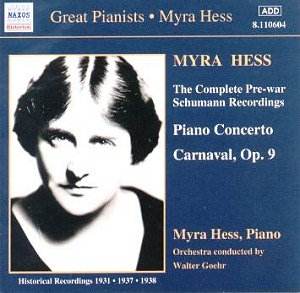Pianophiles will either wince or smile – according
to taste – at the memory of Abram Chasins’ outrageously florid passages
on English musicians in his book ‘Speaking of Pianists’: All within
this gracious assemblage have long breathed the reposeful air of
England, he wrote with a baroque flourish allowing that I have
been charmed by Myra Hess and her art since I first went to London.
On only a few occasions has her playing been that of a great pianist.
Which of course begs several questions too big to deal with here
though one question does spring to mind; had he heard her Schumann?
Naxos here compiles all Hess’s few pre-War Schumann
recordings. They display all her virtues of characterisation, tonal
allure, unforced drama and a kind of vanity-shorn rightness that constantly
illuminates the text. There is nothing at all outsize about these performances;
the Concerto in particular doesn’t aspire to the heaven-storming heights
and it is I think, in any case, inferior in terms of greatness of understanding
and conveyance of inner meaning to Carnaval, which here receives
one of the great gramophonic readings. Hess for example would never
have contemplated the piston hammered Papillons of, say, Simon
Barere (he’s in my thoughts because I’m reviewing a live Carnegie Hall
concert but he stands as representative of an altogether different Schumann
aesthetic, a kinetic, vertiginous and sometimes ungovernable one). It’s
difficult to appreciate quite how difficult to achieve is Hess’s naturalness
of expression. Her rubati are unforced, her colourings and voicings
perfectly apposite. The più moto of the Préambule
however is fantastically fluent, her Arlequin truly insouciant,
her left hand in the Valse noble vivid and beautiful, Eusebius
gravely and deeply poetic. Papillon then is fast but not hammered
– it has a skipping elegance not a pneumatic insistence – and if Chopin
is hardly agitato as marked then it loses nothing in depth
of utterance. How many other pianists really explore the rhythmic implications
of the Valse allemande as does Hess; how many reconcile the lyrical
and the passionate that lie at the heart of Paganini. In every
way this is a desert island Carnaval.
The piquancies of Vogel als Prophet are explored
in a 1931 New York recording but the other principal reason for acquiring
this disc is the Concerto. This is her earlier recording; she made another
recording of it in 1954 with Rudolf Schwarz. Still I don’t think memories
of the later recording will efface certain imperishable features of
this earlier one. The A flat major episode in the first movement is
gorgeously but not indulgently poetic, with the echoing clarinet phrases
prominent. Hess’s sense of movement and tempo relation was seldom as
necessary as in this work, and her sovereign control of tonal gradation
treasurable. In the cadenza her quasi-improvisatory way is strongly
animated and persuasive. Her Intermezzo has an elfin and rarefied
charm and she matches her phrasing with that of the orchestral statements
with architectural and tonal sagacity. She absorbs the contrastive sections
of the finale with glittering but cool musicality and there is no heroic
driving peroration. If this finale doesn’t galvanize, ignite, combust
– or what you will – it’s playing entirely consonant with Hess’ approach
as a whole and wholeness was very much her great gift as a Schumann
player.
Nalen Antoni’s thought-provoking note lays bare the
Schumann performance tradition from which Hess emerged. The transfer
of Carnaval is good but I had trouble with the Concerto – there’s
a slightly opaque and muffled quality to it that I found lacked clarity.
As for florid Abram Chasins I have to say I found Hess both charming
and a great pianist, in the Carnaval at least.
Jonathan Woolf

